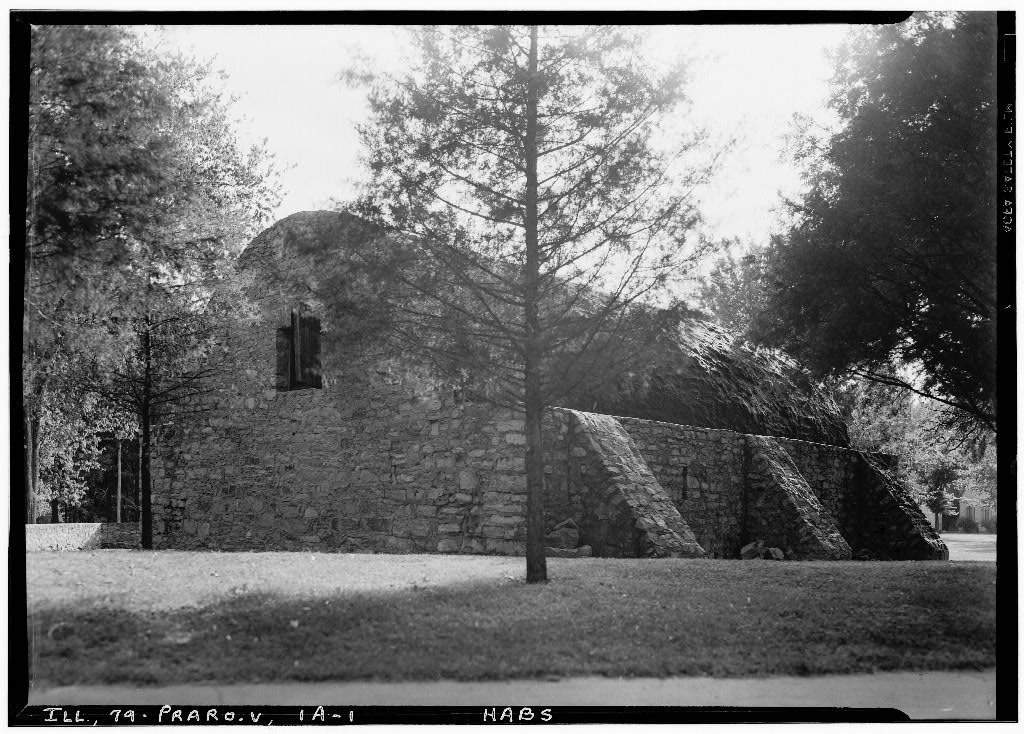The world looks different from Chicago. For many of us raised in the city or currently living here, we have a decidedly Chicago-centric sense of the past, present, and future. Indeed, Chicago easily takes up all of the space on our horizon, the bandwidth on our computers, and the curiosity and imagination our minds can summon. But a century before Chicago rose to preeminence, other places in Illinois commanded attention and defined what was then called the Illinois Country. Fort de Chartres was one such place.

The powder magazine at Fort de Chartres, photographed by Lester Jones in October 1940, is believed to be the oldest building in Illinois. Library of Congress Prints and Photographs Division, Historic American Buildings Survey, HABS ILL, 79-PRARO.V1A—1
This year marked the 250th anniversary of the surrender of Fort de Chartres by the French to the British under the command of Captain Thomas Stirling and the Forty-Second (Royal Highland) Regiment of Foot. Located on the eastern bank of the Mississippi River a few miles west of present-day Prairie du Rocher in southwestern Illinois, the original wooden fort built in 1720 was replaced with a stone structure in the 1750s in an effort to abate its deterioration due to ongoing flooding. Fort de Chartres played a strategic role in New France, serving as the commercial, governmental, and administrative center of the Illinois Country. Following the Treaty of Paris in 1763, which brought the French and Indian War (1754–63) to an end, the French surrendered their North American possessions east of the Mississippi to the British; and British troops occupied French forts immediately.
Fort de Chartres was the exception. The British recognized the strategic importance of the fort and sought to claim it quickly, but their initial efforts to seize it were thwarted by a group of Ottawa organized by Chief Pontiac. The first expedition, led by Lieutenant Alexander Fraser and including members of the Forty-Second Highlanders, set out from Fort Pitt (the current site of Pittsburgh) on March 22, 1763. Arriving on April 17, 1765, the French treated Fraser respectfully, but the Ottawa, who were dissatisfied with the British as their new trading partners and organized to resist, seized Fraser and his men and imprisoned them. As the situation grew increasingly dire, Fraser and his men escaped in May and made their way down the Mississippi River to New Orleans.
Captain Stirling led the second expedition to secure control of Fort de Chartres, leaving Fort Pitt on August 24, 1765, with more than a hundred members of the Forty-Second. The group made its way west via the Ohio and other rivers, reaching the Mississippi on September 30. Stirling and his forces took possession of Fort de Chartres on October 10, 1765. He described the scene in his journal of the expedition:
There were about Forty French Soldiers in the Colony, — I was sent with the Officer at the Gate, with the same number of Men to relieve him. His Guard was compos’d of old Men looking like the Invalids without any sort of uniform. Most of them had on Jackets of different colours and slouch’d Hats, and their Arms seem’d to be old and in very indifferent order. When the Sentries were relieved and the Guard just ready to march off, The French colours were pull’d down. Upon sight of this those Honest Old Veterans were greatly Chagrind. They could not help venting their indignation, by shrugging their shoulders and declaring when they fought under Marshals Berwick Saxe and Lowendale, no such dishonor was them ever seen. In fact, all Europe trembled at the French name.
The seemingly insignificant transfer of power Captain Stirling described was a portent of an economic, social, and cultural transformation of unprecedented scale. The British and the French would face each other as enemies once again just thirteen years later in America’s Revolutionary War; but the French reign of influence in the New World was waning when Fort de Chartres surrendered, and it would come to an end with the sale of the Louisiana Territory to President Thomas Jefferson in 1803.
Today, Fort de Chartres is a National Historic Landmark and an Illinois State Historic Site and is home to the state’s oldest standing building. And if you are from Chicago, and you want to expand your world view, you should make a visit.
Explore a detailed account of Captain Stirling’s expedition
This is the website of the Forty-Second Royal Highlanders of Lafayette, Indiana, a historical reenactment group that portrays the regiment as it appeared in North America around 1777.